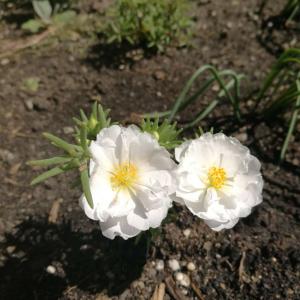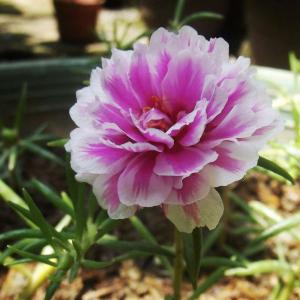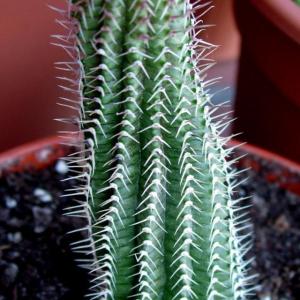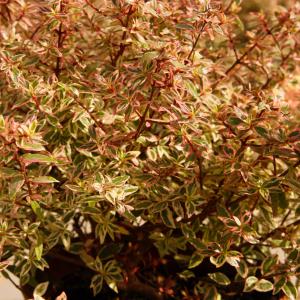文章
Miss Chen
2017年09月20日

Esta Amaryllidaceae, familia a la que pertenece el lirio del Amazonas, Eucharis grandiflora, es el resultado del cruce natural entre Eucharis moorei y Eucaris sanderi. Su hábitat se distribuye entre el oeste de Colombia y el oeste de Ecuador en América del Sur. Sus flores tienen forma de estrella y son de color blanco, las hojas son de color verde oscuro. Es una gran planta de interior que necesita ambientes luminosos y buena circulación de aire.

Es una planta herbácea, perenne y bulbosa que puede alcanzar una altura de unos 40 cm. Aunque los tallos florales pueden llegar hasta los 70 cm de altura. Las flores son grandes y se presentan en racimos de entre 3 y 6 ejemplares. La podemos cultivar en el suelo o en maceta y tanto en interior como en exterior, dependiendo claro está de nuestra localización pues al ser una planta tropical no tolera el frío. En todo caso necesitará un lugar luminoso y a la sombra pues el sol directo la quema con facilidad.

Puede tener hasta tres floraciones al año y necesitará un suelo suelto formado por 2 partes de tierra, 2 de marga o arcilla, 1 de arena y 1 de materia orgánica tipo compost o estiércol curado. Para estimular la floración se puede usar también harina de huesos. Sus bulbos miden unos 6 cm de diámetro y si los cultivamos en el suelo sembraremos 3-4 juntos y si queremos sembrar más lo haremos a unos 40-50 cm de separación para que las plantas tengan suficiente espacio para desarrollarse convenientemente.

El lirio del Amazonas necesita riegos regulares para mantener un buen grado de humedad. Es conveniente incluso pulverizar un poco de agua cada día para mantener esa humedad ambiente que precisa. Y en los días calurosos no le irá nada mal un poco de agua a diario. Entre el invierno y la primavera es el momento ideal para recoger los bulbos que haya producido la planta con vistas a su reproducción.

A partir de que se marchiten sus últimas flores seguiremos regando durante tres meses más. Cuando la planta se seque por completo dejaremos de regar y cuando el suelo esté bien seco sacaremos los bulbos. Los guardaremos en una bolsa de plástico perforada y acabaremos de rellenar la bolsa con perlita u otro material similar que absorba la humedad. Colocaremos la bolsa en la nevera, en el cajón de las verduras. Pueden aguantar perfectamente unos 4 meses.
Mantendremos la bolsa ligeramente húmeda y libre de contacto con ningún otro vegetal. A los 4 meses podemos sacar los bulbos de la nevera y los plantaremos. Durante los primeros 10 días procuraremos dejarlos en un lugar fresco y ventilado para que así puedan brotar correctamente. Los brotes aparecerán en el lado más iluminado del recipiente y cuidaremos mucho el riego para que no se pudran pues son muy sensibles al exceso de humedad en este momento.

Es una planta herbácea, perenne y bulbosa que puede alcanzar una altura de unos 40 cm. Aunque los tallos florales pueden llegar hasta los 70 cm de altura. Las flores son grandes y se presentan en racimos de entre 3 y 6 ejemplares. La podemos cultivar en el suelo o en maceta y tanto en interior como en exterior, dependiendo claro está de nuestra localización pues al ser una planta tropical no tolera el frío. En todo caso necesitará un lugar luminoso y a la sombra pues el sol directo la quema con facilidad.

Puede tener hasta tres floraciones al año y necesitará un suelo suelto formado por 2 partes de tierra, 2 de marga o arcilla, 1 de arena y 1 de materia orgánica tipo compost o estiércol curado. Para estimular la floración se puede usar también harina de huesos. Sus bulbos miden unos 6 cm de diámetro y si los cultivamos en el suelo sembraremos 3-4 juntos y si queremos sembrar más lo haremos a unos 40-50 cm de separación para que las plantas tengan suficiente espacio para desarrollarse convenientemente.

El lirio del Amazonas necesita riegos regulares para mantener un buen grado de humedad. Es conveniente incluso pulverizar un poco de agua cada día para mantener esa humedad ambiente que precisa. Y en los días calurosos no le irá nada mal un poco de agua a diario. Entre el invierno y la primavera es el momento ideal para recoger los bulbos que haya producido la planta con vistas a su reproducción.

A partir de que se marchiten sus últimas flores seguiremos regando durante tres meses más. Cuando la planta se seque por completo dejaremos de regar y cuando el suelo esté bien seco sacaremos los bulbos. Los guardaremos en una bolsa de plástico perforada y acabaremos de rellenar la bolsa con perlita u otro material similar que absorba la humedad. Colocaremos la bolsa en la nevera, en el cajón de las verduras. Pueden aguantar perfectamente unos 4 meses.
Mantendremos la bolsa ligeramente húmeda y libre de contacto con ningún otro vegetal. A los 4 meses podemos sacar los bulbos de la nevera y los plantaremos. Durante los primeros 10 días procuraremos dejarlos en un lugar fresco y ventilado para que así puedan brotar correctamente. Los brotes aparecerán en el lado más iluminado del recipiente y cuidaremos mucho el riego para que no se pudran pues son muy sensibles al exceso de humedad en este momento.
0
0
文章
Dummer. ゛☀
2017年09月14日

A reader from Charleston, South Carolina wrote in to say, "My Southern magnolia (Magnolia grandiflora) has yellow leaves. Is it dying?" The reader had had this balled-and-burlapped specimen for two years; it had been 5 feet tall when installed.
More specifically, this Charleston resident complained of not only sparse flowering in the tree's second spring, but also -- and more worrisome to this gardener -- "yellow leaves in fall that drop off of the tree" (note that this species is evergreen).
So what could be the cause of this?
Possible Reasons Why a Southern Magnolia Has Yellow Leaves
First of all, you need to rule out a nutrient deficiency in your soil. Yellow leaves on Southern magnolias can indicate that your soil has insufficient nitrogen. The only way to determine for sure whether or not this is the problem is to have a soil test done. If the test results do, in fact, show a nitrogen deficiency, you can fertilize accordingly to raise the nitrogen level. The nitrogen content of a fertilizer is indicated by the first number in the NPK sequence, which should be printed somewhere on the fertilizer bag.
Let's assume that you have had a soil test done and have been able to rule out nitrogen deficiency. What else could be the problem? Sometimes, when Southern magnolia trees develop yellow leaves (often accompanied by the presence of spots), it is only as a prelude to natural shedding (which happens periodically).
However, this seems to occur more often in the spring. With the reader reporting seeing the yellow leaves in fall, it makes one think there could perhaps be a problem with her Southern magnolia in terms of water and/or drainage. Let's expand on that observation.
Too much or too little water are both possibilities, whether you irrigate yourself and/or rely on rainfall.
But the issue of water is inextricably intertwined with that of drainage. Why? Because even if there is sufficient water, if it percolates through the ground too rapidly, the Southern magnolia tree would not be able to take full advantage of it. Conversely, if the drainage is impeded by an overly clayey soil, and you get a lot of rain and/or overwater your specimen, the roots will "drown." Either extreme is bad news.
If you think drainage is an issue, you may want to transplant your tree to another area, after first preparing the soil for optimal drainage. A loamy soil is ideal.
Growing Information for Southern Magnolia Trees
Popular in the American Southeast, to which region these plants are indigenous, Southern magnolia trees are best grown in USDA plant hardiness zones 7-9. Grow them in full sun to partial shade. Since they like fertile soil, ideal growing conditions would include a soil enriched with compost. They like a soil pH that is on the acidic side.
These trees are classified as broadleaf evergreens. They can grow to be as high as 80 feet tall. The fragrant flowers are white. Bloom time is late spring. Even the cone-like structure left over after flowering is attractive; it can be as much as 5 inches long.
If you live in the North and wish to grow a Southern magnolia, look for 'Bracken’s Brown Beauty,' a cold-hardy cultivar, which is suitable for all the way up to zone 5b.

More specifically, this Charleston resident complained of not only sparse flowering in the tree's second spring, but also -- and more worrisome to this gardener -- "yellow leaves in fall that drop off of the tree" (note that this species is evergreen).
So what could be the cause of this?
Possible Reasons Why a Southern Magnolia Has Yellow Leaves
First of all, you need to rule out a nutrient deficiency in your soil. Yellow leaves on Southern magnolias can indicate that your soil has insufficient nitrogen. The only way to determine for sure whether or not this is the problem is to have a soil test done. If the test results do, in fact, show a nitrogen deficiency, you can fertilize accordingly to raise the nitrogen level. The nitrogen content of a fertilizer is indicated by the first number in the NPK sequence, which should be printed somewhere on the fertilizer bag.

Let's assume that you have had a soil test done and have been able to rule out nitrogen deficiency. What else could be the problem? Sometimes, when Southern magnolia trees develop yellow leaves (often accompanied by the presence of spots), it is only as a prelude to natural shedding (which happens periodically).
However, this seems to occur more often in the spring. With the reader reporting seeing the yellow leaves in fall, it makes one think there could perhaps be a problem with her Southern magnolia in terms of water and/or drainage. Let's expand on that observation.
Too much or too little water are both possibilities, whether you irrigate yourself and/or rely on rainfall.

But the issue of water is inextricably intertwined with that of drainage. Why? Because even if there is sufficient water, if it percolates through the ground too rapidly, the Southern magnolia tree would not be able to take full advantage of it. Conversely, if the drainage is impeded by an overly clayey soil, and you get a lot of rain and/or overwater your specimen, the roots will "drown." Either extreme is bad news.
If you think drainage is an issue, you may want to transplant your tree to another area, after first preparing the soil for optimal drainage. A loamy soil is ideal.

Growing Information for Southern Magnolia Trees
Popular in the American Southeast, to which region these plants are indigenous, Southern magnolia trees are best grown in USDA plant hardiness zones 7-9. Grow them in full sun to partial shade. Since they like fertile soil, ideal growing conditions would include a soil enriched with compost. They like a soil pH that is on the acidic side.

These trees are classified as broadleaf evergreens. They can grow to be as high as 80 feet tall. The fragrant flowers are white. Bloom time is late spring. Even the cone-like structure left over after flowering is attractive; it can be as much as 5 inches long.
If you live in the North and wish to grow a Southern magnolia, look for 'Bracken’s Brown Beauty,' a cold-hardy cultivar, which is suitable for all the way up to zone 5b.
0
0
文章
Miss Chen
2017年08月15日

Portulaca grandiflora, commonly called moss rose, grows as a colorful, spreading ground cover in beds, borders and containers. This annual flower grows readily from seed broadcast directly in the garden bed, or you can plant it from transplants in spring after frost danger has passed. Moss rose is related to the invasive annual weed purslane (Portulaca oleracea). Although the cultivated version doesn't spread as readily, it can also become invasive in some areas.
The Right Location

Moss rose grows well in rocky, sandy soil that drains quickly. The plants spread fast, covering up to 12 inches of bed and growing about 6 inches tall. When adding plants to the garden, give moss rose the room it needs to reach its full spread and avoid planting tall plants nearby that may shade it. Moss rose spreads by self-seeding, so growing it in a site where you want it to return each year is the best choice. In mild, frost-free climates it sometimes becomes invasive and shouldn't be planted.
A Little Drink

Although highly drought-tolerant, you will be rewarded with more flowers and lusher foliage if you water moss rose regularly. Provide about 1 inch of water weekly unless there is a comparable amount of rainfall. Container-grown plants may need daily watering, so water these when the top 1 inch of soil feels dry. Overhead watering, which wets the foliage, damages the flowers or causes them to drop prematurely. Water near the base of the plants so the flowers and leaves stay dry. Moss rose doesn't need fertilizers and can grow well in poor soil.
Off With Their Heads

Regular deadheading serves two purposes: It removes the old flowers so they don't form seeds, and it cleans up the plants while encouraging more flowers. Grasp the stem behind the wilted flower and pinch it off, removing both the old bloom and the swollen seed-producing structure at the base of the flower. Moss rose flowers from midsummer through fall, so you may need to deadhead a few times a week. You can also trim back dead or damaged stems to a leaf or bud. Simply pinch off the stem or cut it off with shears that have been wiped with a cloth soaked with rubbing alcohol.
Watch for Problems

Few pests or diseases bother moss rose. Aphids, small pear-shaped, sap-sucking insects, may sometimes feed on the foliage. Rinse them off with a sharp spray of water aimed at the undersides of the leaves. Root rot is an issue that will kill the plants in wet or poorly drained soil, but planting in the appropriate site prevents problems. Rust, a fungal disease, may infect a plant. The fungus causes the stems and leaves to swell, and white pustules form on the foliage. Pull up and destroy infected plants so they don't spread the fungal spores.
The Right Location

Moss rose grows well in rocky, sandy soil that drains quickly. The plants spread fast, covering up to 12 inches of bed and growing about 6 inches tall. When adding plants to the garden, give moss rose the room it needs to reach its full spread and avoid planting tall plants nearby that may shade it. Moss rose spreads by self-seeding, so growing it in a site where you want it to return each year is the best choice. In mild, frost-free climates it sometimes becomes invasive and shouldn't be planted.
A Little Drink

Although highly drought-tolerant, you will be rewarded with more flowers and lusher foliage if you water moss rose regularly. Provide about 1 inch of water weekly unless there is a comparable amount of rainfall. Container-grown plants may need daily watering, so water these when the top 1 inch of soil feels dry. Overhead watering, which wets the foliage, damages the flowers or causes them to drop prematurely. Water near the base of the plants so the flowers and leaves stay dry. Moss rose doesn't need fertilizers and can grow well in poor soil.
Off With Their Heads

Regular deadheading serves two purposes: It removes the old flowers so they don't form seeds, and it cleans up the plants while encouraging more flowers. Grasp the stem behind the wilted flower and pinch it off, removing both the old bloom and the swollen seed-producing structure at the base of the flower. Moss rose flowers from midsummer through fall, so you may need to deadhead a few times a week. You can also trim back dead or damaged stems to a leaf or bud. Simply pinch off the stem or cut it off with shears that have been wiped with a cloth soaked with rubbing alcohol.
Watch for Problems

Few pests or diseases bother moss rose. Aphids, small pear-shaped, sap-sucking insects, may sometimes feed on the foliage. Rinse them off with a sharp spray of water aimed at the undersides of the leaves. Root rot is an issue that will kill the plants in wet or poorly drained soil, but planting in the appropriate site prevents problems. Rust, a fungal disease, may infect a plant. The fungus causes the stems and leaves to swell, and white pustules form on the foliage. Pull up and destroy infected plants so they don't spread the fungal spores.
0
0
文章
Miss Chen
2017年08月15日

Portulaca grandiflora, also called moss rose, tends to self-seed, but harvesting seeds from this annual plant helps keep it where you want it. Moss rose quickly spreads in full-sun, dry areas when seed capsules are left on the plant. Growing 4 to 8 inches tall and 6 to 24 inches wide, moss rose varieties include the early-flowering Margarita series, "Sundial," which produces early, double flowers in sunset colors, and "Calypso," which features white, yellow, orange, pink or purple double flowers.

Moss Rose Varieties
Suppliers sell moss rose cultivars, hybrids, strains, heirlooms and mixes, and only some of these come true from seed. Cultivars and hybrids are specially bred to have certain characteristics, such as flower color, shape or performance, but they don't pass on these characteristics to their offspring. Some cultivar and hybrid seeds may not even sprout. Strains and heirloom plants are often older varieties, and these are more reliable in producing plants that are similar to themselves. Mixes are different varieties mixed together, and these may cross-fertilize, producing unpredictable results. Moss rose cultivars and hybrids are often more expensive than other varieties. If you aren't sure what type of moss rose you're growing, ask the garden center where you bought it.
Harvesting Seed
Moss rose seeds are fine as dust and develop inside seed capsules, which you can harvest. Moss rose flowers in summer. The seed capsules are 1/8 to 1/4 inch long, and they develop after the flowers are pollinated. When the seed capsules are ripe, they turn dry and papery and split open. Inside are many tiny, blue-gray seeds.

Harvest ripe moss rose seed capsules on a dry, sunny day. If you aren't sure whether the capsules are ripe, gently rub one between your thumb and forefinger. To avoid spilling the seeds on the soil, where they may sprout the following year, take a seed capsule indoors before testing it. Pinch off the ripe capsules and put them in a paper bag.
Separating Seed
Moss rose seeds should be separated from the seed capsules and dried before storing. Crush the seed capsules over a sheet of newspaper in a draft-free place. Place a colander on another sheet of newspaper, and pour the the crushed seed capsules into the colander. Gently shake the colander so that the seeds fall through but the capsule debris is left behind.
Moss rose seeds must be stored in an airtight container. Lift the newspaper and close it along its crease. Place one edge of the crease at the lip of an open airtight container, and lift the newspaper so the seeds slide into the container. Flick the newspaper once or twice with your finger to loosen any remaining seeds, put the newspaper down, then seal the container.
Storing Seed
A refrigerator is the best place for storing moss rose seeds, where they will remain fresh for sowing the following year. Put moss rose seeds in their sealed, airtight container in a refrigerator or similar cool, dry place such as a basement or cellar. Don't place the container in direct light, and don't open the container to check on the seeds until it's time to sow them. Direct light warms up the inside of the container, damaging the seeds, and opening the container allows moisture inside, which encourages the seeds to rot.

Moss Rose Varieties
Suppliers sell moss rose cultivars, hybrids, strains, heirlooms and mixes, and only some of these come true from seed. Cultivars and hybrids are specially bred to have certain characteristics, such as flower color, shape or performance, but they don't pass on these characteristics to their offspring. Some cultivar and hybrid seeds may not even sprout. Strains and heirloom plants are often older varieties, and these are more reliable in producing plants that are similar to themselves. Mixes are different varieties mixed together, and these may cross-fertilize, producing unpredictable results. Moss rose cultivars and hybrids are often more expensive than other varieties. If you aren't sure what type of moss rose you're growing, ask the garden center where you bought it.
Harvesting Seed
Moss rose seeds are fine as dust and develop inside seed capsules, which you can harvest. Moss rose flowers in summer. The seed capsules are 1/8 to 1/4 inch long, and they develop after the flowers are pollinated. When the seed capsules are ripe, they turn dry and papery and split open. Inside are many tiny, blue-gray seeds.

Harvest ripe moss rose seed capsules on a dry, sunny day. If you aren't sure whether the capsules are ripe, gently rub one between your thumb and forefinger. To avoid spilling the seeds on the soil, where they may sprout the following year, take a seed capsule indoors before testing it. Pinch off the ripe capsules and put them in a paper bag.
Separating Seed
Moss rose seeds should be separated from the seed capsules and dried before storing. Crush the seed capsules over a sheet of newspaper in a draft-free place. Place a colander on another sheet of newspaper, and pour the the crushed seed capsules into the colander. Gently shake the colander so that the seeds fall through but the capsule debris is left behind.
Moss rose seeds must be stored in an airtight container. Lift the newspaper and close it along its crease. Place one edge of the crease at the lip of an open airtight container, and lift the newspaper so the seeds slide into the container. Flick the newspaper once or twice with your finger to loosen any remaining seeds, put the newspaper down, then seal the container.
Storing Seed
A refrigerator is the best place for storing moss rose seeds, where they will remain fresh for sowing the following year. Put moss rose seeds in their sealed, airtight container in a refrigerator or similar cool, dry place such as a basement or cellar. Don't place the container in direct light, and don't open the container to check on the seeds until it's time to sow them. Direct light warms up the inside of the container, damaging the seeds, and opening the container allows moisture inside, which encourages the seeds to rot.
0
0
文章
Miss Chen
2017年08月14日

If you have a sunny spot in the garden that tends to stay dry during the summer, a cheerful little plant called moss rose (Portulaca grandiflora) could be the perfect choice to brighten this area. A semi-succulent, creeping plant, it's named for the roselike appearance of its flowers, that come in pink, red, yellow, orange or white. A tough, easy-to-grow plant, moss rose is an annual, but it self-seeds readily and can keep an area filled with colorful flowers year after year.

New Seeds From Old Flowers
Moss rose comes in many different cultivars, some with single flowers and others with extra-showy, double flowers. Flowers on all types grow on the tips on the plant's stems, opening fully in the sun and closing overnight. The flowers also stay closed on overcast days. Grow the plant in a spot with excellent drainage that gets full sun all day to get the most flowers, which will open nonstop from midsummer into fall.
Although moss rose doesn't live through winter and is easily damaged by cold weather, you can promote a self-renewing plot by leaving the flowers on the plant. They will eventually wilt and, over time, petals will fall. Next, the remaining central part of the old flower develops tiny black seeds that drop to the ground when mature.
Seedlings the Following Spring
If you want to see new moss rose seedlings in the same spot next spring, avoid raking or disturbing the soil under the plants, because the seeds need light to germinate. When fall arrives and the plants begin to die back, cut them off carefully just above the soil line to keep the area tidy, but don't pull the plants out by the roots to avoid burying seeds that have dropped. If you live where winter temperatures fall below freezing, the remaining plant parts will die back and dry up before spring arrives.
When weather warms the following spring, keep the soil in the self-seeded area moist. Once moss rose seedlings appear, you can allow them to grow in place or carefully dig them up, adding them to containers or re-locating them in the garden.
Flowers Until Fall
Like many flowering plants, moss rose slows flower production once it produces mature seeds. Eventually, flowering stops and the plant starts to fade near the end of the season. But removing spent flowers as they appear -- called deadheading -- helps keep new flowers coming throughout the season and promotes strong new growth.

You can have the best of both worlds by removing all but a few old flowers from the plant, letting the remaining blooms fade naturally and set seeds. In response, the plant continues making new flower buds, keeping new flowers coming -- but fewer of them -- later in the season. Use sharp shears when deadheading to cut off stem tips that bear flowers, wiping your blade with rubbing alcohol between cuts to discourage spread of plant diseases.
Other Care Issues
Although the moss rose is drought-tolerant, it flowers best when it gets regular water, with about 1 inch of water weekly, including rain, being best. A naturally creeping plant, it can spread to cover an area up to 2 feet wide, developing into a flower-covered, 6-inch-tall mound.
This plant is generally free of pests and diseases, although it might develop root rot if grown in an overly wet area. An affected plant has soft, brown roots and tends to die back, with damage starting at its base. It's best to dig up and throw out any affected plant and re-plant new seedlings in a drier area.

New Seeds From Old Flowers
Moss rose comes in many different cultivars, some with single flowers and others with extra-showy, double flowers. Flowers on all types grow on the tips on the plant's stems, opening fully in the sun and closing overnight. The flowers also stay closed on overcast days. Grow the plant in a spot with excellent drainage that gets full sun all day to get the most flowers, which will open nonstop from midsummer into fall.
Although moss rose doesn't live through winter and is easily damaged by cold weather, you can promote a self-renewing plot by leaving the flowers on the plant. They will eventually wilt and, over time, petals will fall. Next, the remaining central part of the old flower develops tiny black seeds that drop to the ground when mature.
Seedlings the Following Spring
If you want to see new moss rose seedlings in the same spot next spring, avoid raking or disturbing the soil under the plants, because the seeds need light to germinate. When fall arrives and the plants begin to die back, cut them off carefully just above the soil line to keep the area tidy, but don't pull the plants out by the roots to avoid burying seeds that have dropped. If you live where winter temperatures fall below freezing, the remaining plant parts will die back and dry up before spring arrives.
When weather warms the following spring, keep the soil in the self-seeded area moist. Once moss rose seedlings appear, you can allow them to grow in place or carefully dig them up, adding them to containers or re-locating them in the garden.
Flowers Until Fall
Like many flowering plants, moss rose slows flower production once it produces mature seeds. Eventually, flowering stops and the plant starts to fade near the end of the season. But removing spent flowers as they appear -- called deadheading -- helps keep new flowers coming throughout the season and promotes strong new growth.

You can have the best of both worlds by removing all but a few old flowers from the plant, letting the remaining blooms fade naturally and set seeds. In response, the plant continues making new flower buds, keeping new flowers coming -- but fewer of them -- later in the season. Use sharp shears when deadheading to cut off stem tips that bear flowers, wiping your blade with rubbing alcohol between cuts to discourage spread of plant diseases.
Other Care Issues
Although the moss rose is drought-tolerant, it flowers best when it gets regular water, with about 1 inch of water weekly, including rain, being best. A naturally creeping plant, it can spread to cover an area up to 2 feet wide, developing into a flower-covered, 6-inch-tall mound.
This plant is generally free of pests and diseases, although it might develop root rot if grown in an overly wet area. An affected plant has soft, brown roots and tends to die back, with damage starting at its base. It's best to dig up and throw out any affected plant and re-plant new seedlings in a drier area.
0
0
文章
Miss Chen
2017年08月10日

Tree roses, also called standard roses, are bush roses that have been budded onto a tall stem or trunk. Tree roses grow up to 4 feet tall.

Types
Tree roses can be grafted from almost any rose variety. The most common types are hybrid tea, grandiflora and floribunda. Hybrid tea roses bloom on single stems and come in a vast array of colors. Floribunda roses are short, hardy bush roses that bloom in clusters. Grandiflora roses are like hybrid tea roses in their plant height and popularity as cut flowers, but have several blooms per stem and bloom more frequently than hybrid tea varieties.
Features
Prune tree roses according to the type of rose that is grafted onto the stem. Varieties that bloom only once per season should be pruned after flowering. Varieties that bloom repeatedly should be pruned during their dormant season.

Geography
Roses grow best in full sun and well-drained acidic soil with a pH between 5.5 and 7.0. Amend soil with organic matter prior to planting to encourage drainage and help prevent iron deficiency. Mulch after planting to a depth of 2 to 4 inches.

Types
Tree roses can be grafted from almost any rose variety. The most common types are hybrid tea, grandiflora and floribunda. Hybrid tea roses bloom on single stems and come in a vast array of colors. Floribunda roses are short, hardy bush roses that bloom in clusters. Grandiflora roses are like hybrid tea roses in their plant height and popularity as cut flowers, but have several blooms per stem and bloom more frequently than hybrid tea varieties.
Features
Prune tree roses according to the type of rose that is grafted onto the stem. Varieties that bloom only once per season should be pruned after flowering. Varieties that bloom repeatedly should be pruned during their dormant season.

Geography
Roses grow best in full sun and well-drained acidic soil with a pH between 5.5 and 7.0. Amend soil with organic matter prior to planting to encourage drainage and help prevent iron deficiency. Mulch after planting to a depth of 2 to 4 inches.
0
0
文章
Dummer. ゛☀
2017年08月06日

BOTANICAL NAME: Petunia
PLANT TYPE: Flower
FLOWER COLOR: PinkPurpleRedWhiteYellow
BLOOM TIME: SpringSummerFall
Petunias are divided into two different groups:
Grandiflora petunias have very large flowers and are best grown in containers or hanging baskets (because they are more susceptible to rain damage).
Multiflora petunias have smaller, but more abundant flowers and are ideal for summer bedding or in a mixed border (because they are more tolerant to wet weather).
PLANTING
You can grow petunias from seeds, but it is easier to grow them from transplants. If you are going to grow from seeds, start them indoors 10 to 12 weeks before you want to set them outside. Petunia seeds are very small and needs lots of light in order to germinate. Remember to water them. When the plants have three leaves, you can plant them outside.
It’s best to buy transplants and plant them in light, well-drained soil in full sun after the last spring frost. (See your local frost dates.) Petunias can grow in partial shade, but they will have fewer flowers. It’s better if the plants have shelter from the wind.
Space the plants about 1 foot apart.
If you’re planting petunias in containers, use a soil-less mix.
CARE
Petunias are tolerant of heat so you don’t have to water them regularly. A thorough watering once a week should be sufficient (unless there are prolonged periods of drought in your area). The spreading types and those in containers require more frequent watering though.
Fertilize your plants monthly to ensure good growth. Double-flowered cultivars like a biweekly dose of fertilizer.
Remove faded/dead flowers to prolong blooming.
PESTS/DISEASES
Aphids
Caterpillars
Leaf miners
Gray mold
Bacterial soft rot
Leaf spots
Viruses
PLANT TYPE: Flower
FLOWER COLOR: PinkPurpleRedWhiteYellow
BLOOM TIME: SpringSummerFall
Petunias are divided into two different groups:
Grandiflora petunias have very large flowers and are best grown in containers or hanging baskets (because they are more susceptible to rain damage).
Multiflora petunias have smaller, but more abundant flowers and are ideal for summer bedding or in a mixed border (because they are more tolerant to wet weather).

PLANTING
You can grow petunias from seeds, but it is easier to grow them from transplants. If you are going to grow from seeds, start them indoors 10 to 12 weeks before you want to set them outside. Petunia seeds are very small and needs lots of light in order to germinate. Remember to water them. When the plants have three leaves, you can plant them outside.
It’s best to buy transplants and plant them in light, well-drained soil in full sun after the last spring frost. (See your local frost dates.) Petunias can grow in partial shade, but they will have fewer flowers. It’s better if the plants have shelter from the wind.
Space the plants about 1 foot apart.
If you’re planting petunias in containers, use a soil-less mix.

CARE
Petunias are tolerant of heat so you don’t have to water them regularly. A thorough watering once a week should be sufficient (unless there are prolonged periods of drought in your area). The spreading types and those in containers require more frequent watering though.
Fertilize your plants monthly to ensure good growth. Double-flowered cultivars like a biweekly dose of fertilizer.
Remove faded/dead flowers to prolong blooming.

PESTS/DISEASES
Aphids
Caterpillars
Leaf miners
Gray mold
Bacterial soft rot
Leaf spots
Viruses
0
1
文章
Miss Chen
2017年07月19日


Nombre científico o latino: Carissa grandiflora
Sinónimo: Carissa macrocarpa
Nombre común o vulgar: Carisa Cerezo de Natal, Ciruelo de Natal.
Familia: Apocynaceae.
Origen: Sudáfrica, KwaZulu, Natal.
Hojas: opuestas, enteras, coriáceas, ovales, verde intenso, de unos 7 cm de largo.
Sus flores atraen mucho a las mariposas.

Sus raíces son medicinales.
Es un arbusto espectacular por sus hojas persistentes y sus grandes frutos.
En su hábitat vive en dunas arenosas cerca del mar.
Planta de maceta y jardinera y pequeños setos.
Sol o sombra parcial.
Suelos bien drenados.
0
0
文章
Miss Chen
2017年07月17日


Nombre científico o latino: Abelia x grandiflora
Nombre común o vulgar: Abelia
Familia: Caprifoliaceae.
Arbusto semicaducifolio, ramas arqueadas y rojizas.
Arbusto ramificado de follaje persistente, de 1-1,5 m de altura y hasta 3 m.
También se cultivan variedades de porte bajo.
Es un arbusto de hoja semicaduca.
Follaje: semipersistente; hojas ovales, opuestas.
Hojas opuestas, ovadas u ovado-lanceoladas, cortamente pecioladas, margen aserrado.
Flores: de 1-1,5 cm de largo, blanco-rosadas, dispuestas en inflorescencia en la extremidad de las ramitas.
Después de la floración persiste el cáliz de color rojizo.
Época de floración: desde la primavera hasta principios del otoño.
Es una planta poco común por su período de floración excepcionalmente largo.
Flores tubulares coloreadas de blanco rosáceo, ligeramente perfumadas.
Fruto aqueniforme, correoso, alargado y coronado por el cáliz persistente.
Puede plantarse al lado de otras especies, aisladamente e incluso en maceta, pero es mejor que componga masas uniformes o, al menos, que las manchas formadas con ella sean extensas y amplias.
Adaptación: muy buena en variadas condiciones.
Precisa un emplazamiento abrigado en zonas de inviernos fríos.
Las plantas jóvenes tienen que protegerse en invierno.
Suelo blando, permeable, bien abonado y no calcáreo.
Abono orgánico en primavera y otoño.
Es estupenda para crear un macizo de arbustos.
Emplazamiento a pleno sol en los templados y media sombra en climas cálidos.

Florece óptimamente a pleno sol.
En semisombra crece bien, pero florece menos.
Gran rusticidad.
Soporta casi cualquier terreno y exposición.
Siempre se debe situar en lugares resguardados del viento.
Riego abundante en verano y moderado en primavera y otoño.
Quiere agua abundante, aunque es resistente a la falta de agua.
Eliminar hojas y ramas secas a final de la primavera y podar las ramas viejas después de la floración.
Podas periódicas, cortando desde la base los brotes vigorosos.
Si deseamos que presente un aspecto compacto o cerrado, podaremos las ramas principales a la mitad de su longitud en invierno o a principios de la primavera.
Conviene, además, eliminar las ramas deterioradas o enfermas y las que se encuentren visiblemente envejecidas.
Poda ligera después de la floración.
Muy resistente a plagas, quizás algún pulgón.
Enfermedades: oidio.
Multiplicación por esqueje de leña blanda en verano y división en primavera.
Se pueden enraizar estacas con hojas en invernadero o con nebulización (tipo niebla), bien sea en el otoño o en el verano, de madera parcialmente madura, o sea, del crecimiento de la estación en curso.
También es posible enraizar estacas de madera dura en otoño o verano.
0
0
成长记
rologirl
2017年05月29日

I new added a "Mojave Tangerine Purslane (Portulaca grandiflora)" in my "garden"
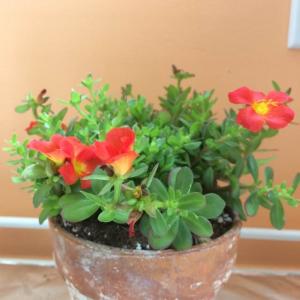

0
0



